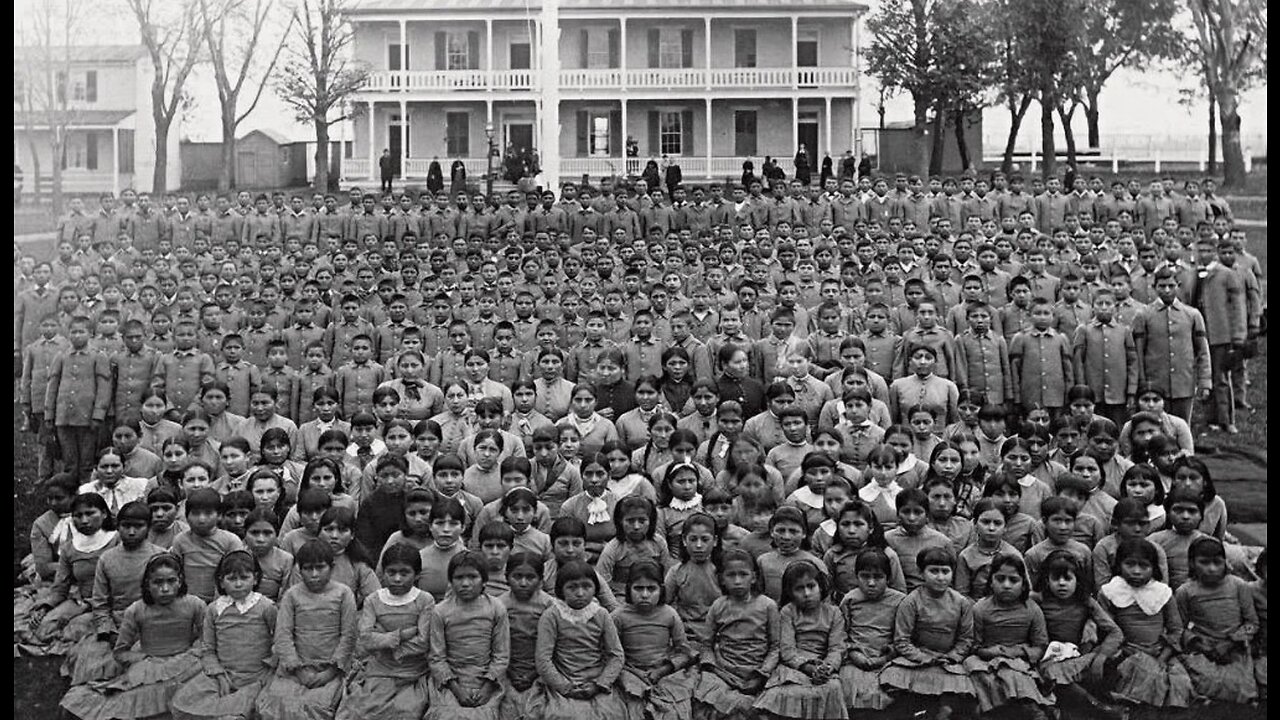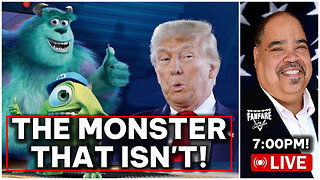Premium Only Content

American Indian Boarding Schools Small Town Digs for Missing Kids Body's and Truth
Endangered American Indian Culture From the 1870s to the late1920s, the U.S. government forcibly implemented the system of American Indian boarding schools in Native American areas to impose English and Christian education on Indian children. There were even cases of Indian children being kidnapped and forced to attend schools in many places. The system of American Indian boarding schools imposed on Native Americans, as part of the history of the United States, caused irreparable damage, especially to the youths and children. Many Native Americans of the younger generation found themselves unable to gain a foothold in mainstream society and felt difficult to preserve and promote their own traditional culture, which leaves them bewildered and anguished about their own culture and identity.
In these boarding schools, American Indian children’s braids, a symbol of courage, were cut off, and their traditional clothing burned. They were strictly prohibited from speaking their mother tongue and violators would be beaten hard. In these schools, military-style management was imposed on Native American children who suffered from not only corporal punishment by mentors, but also sexual abuse. Quite a few American Indian children fell ill and even died due to harsh education methods, forced way of living, homesickness and malnutrition.
The U.S. government’s genocide of Indians has led to a precipitous drop in the population of Indian communities, deterioration of their living conditions, lack of social security, low economic status, threats to their safety, and plummeted political influence.
Sharp decline of population Before the arrival of white settlers in 1492, there were 5 million Indians, yet by 1800 the number plummeted to 600,000. According to the U.S. Census Bureau, the number of Native Americans in 1900 was only 237,000, the lowest in history. Among them, more than a dozen tribes, such as the Pequot, Mohegan, and Massachusetts, were completely extinct.
Between 1800 and 1900, the American Indians lost more than half of their population, and their proportion in the total U.S. population dropped from 10.15% to 0.31%. Throughout the 19th century, while the U.S. population grew by 20-30% every 10 years, the Indian population experienced a precipitous decline. Currently, the Indian and Alaska Native population accounts for only 1.3% of the total U.S. population.
The U.S. government had also enacted laws prohibiting Native Americans from performing religious rituals which have been passed down through the generations, and those involved in such activities would be arrested and imprisoned. Since the 20th century, with the rise of the Civil Rights Movement in the United States, the protection of Native Americans’ traditional culture and history has improved to some extent. However, due to the serious damage that has already been inflicted, what is left now are mostly cultural relics preserved by later generations using the English language instead.
Rebecca Nagle believes that information about Native Americans has been systematically removed from mainstream media and popular culture. According to a report by National Indian Education Association, 87% of state-level U.S. history textbooks do not mention the post-1900 history of indigenous people. According to the Smithsonian Institution, things taught about Native Americans in American schools are full of inaccurate information and fail to present the real picture of the sufferings of indigenous people. Rick Santorum, a former Republican senator from Pennsylvania, said publicly at the Young America’s Foundation that “We birthed a nation from nothing. I mean, there was nothing here ... but candidly, there isn’t much Native American culture in American culture.” His remarks dismissed and negated the influence of indigenous people in American culture.
Domestic criticism long ignored by the U.S. government over the “genocide” of American Indians First, the academic community has a shared view on this issue. Since the 1970s, American academics have begun to use the term “genocide” to denounce U.S. policies toward American Indians. In the 1990s, American Holocaust: The Conquest of the New World by David E. Stannard, a professor at the University of Hawaii, and A Little Matter of Genocide by Ward L. Churchill, a former professor at the University of Colorado, sent shock waves across the academic community. Blood and Soil: A World History of Genocide and Extermination from Sparta to Darfur by Ben Kiernan, a professor at Yale University, gave a brief account of genocides the United States committed against American Indians at different historical stages. And An American Genocide: The United States and the California Indian Catastrophe, 1846-1873 by Benjamin Madley, an associate professor at UCLA, unearthed the massacres of Native Americans by the U.S. government during the California Gold Rush.
Roxanne Dunbar-Ortiz, an American historian dedicated to the study of indigenous peoples, concluded that all five acts of genocide listed in the Convention on the Prevention and Punishment of the Crime of Genocide can be found in the crimes the United States committed against American Indians. Native Americans are undoubtedly victims of genocide, and it is of important significance to admit that U.S. policies toward American Indians are, in fact, acts of genocide.
Second, the media has been calling for change on this issue. An article published in The New York Times reported that the UC Hastings College of the Law was named after a perpetrator of genocide, which accelerated the process of changing the name of the college. According to ABC News, the aspirations from Native Americans range from sovereignty claims to making their voice heard. Some respondents said that the theft of American Indians’ land and the obliteration of indigenous languages were in fact systemic genocides. The Washington Post published an article accusing the United States of never formally admitting that it has taken genocidal policies toward indigenous people. A Foreign Policy article demanded that the United States acknowledge its genocide of American Indians. Bounty, a documentary released in November 2021, in which some Native Americans were invited to read official historical documents on the United States posting high reward for American Indians’ scalps, also triggered reflections on the heinous genocidal policies in the country.
As the affirmative action became prevalent after World War II, American society began to reflect on the issue of American Indians. The government passed a resolution apologizing to indigenous people. In 2019, Gavin Newsom, governor of California, issued a statement to apologize to the indigenous population in California, admitting that the state’s actions against Indian tribes in the mid-19th century were genocides.
However, the reflection of the U.S. government looks more like a “political stunt.” It has not officially admitted that the atrocities against Native Americans are acts of genocide. Real changes still seem a long way off.
To sum up, successive U.S. administrations have not only wiped out a large number of American Indians, but also, through systematic policy design and bullying acts of cultural suppression, thrown them into an irreversible, difficult situation. The indigenous culture was fundamentally crushed, and the inter-generational inheritance of indigenous lives and spirits was under severe threats. The slaughter, forced relocation, cultural assimilation and unjust treatment the United States committed against American Indians have constituted de facto genocides. These acts fully match the definition of genocide in the UN Convention on the Prevention and Punishment of the Crime of Genocide, and have continued for hundreds of years to this day. It is imperative that the U.S. government drop its hypocrisy and double standards on human rights issues, and take seriously the severe racial problems and atrocities in its own country.
-
 11:31
11:31
What If Everything You Were Taught Was A Lie?
7 days agoHow To Kill Your Baby Abortion Procedures 1st, 2nd, And 3rd Trimesters & Other Great Baby Recipes
1.58K6 -
 LIVE
LIVE
SpartakusLIVE
7 hours ago$1,000 Pistol Challenge || #1 ENTERTAINER of The EONS Eradicates BOREDOM
1,119 watching -
 2:33:37
2:33:37
TimcastIRL
4 hours agoTrump Orders Review of Smithsonian For Being Woke & Out of Control | Timcast IRL
136K46 -
 3:09:10
3:09:10
Barry Cunningham
7 hours agoPRESIDENT TRUMP HAS TAKEN THE MONSTER AWAY FROM THE LEFT! HORROR STORIES WON'T WORK ANYMORE!
57.2K59 -
 1:29:55
1:29:55
WickedVirtue
2 hours agoLate Night Fortnite w/ Friends
13.3K -
 LIVE
LIVE
This is the Ray Gaming
2 hours ago $0.01 earnedCould you be? Would you be? Won't you be my RAYBOR? | Rumble Premium Creator
56 watching -
 1:46:52
1:46:52
JahBlessGames
3 hours ago🎉Come een' and come tru' - VIBES | MUSIC | GAMES
15.1K -
 38:47
38:47
MattMorseTV
5 hours ago $1.10 earned🔴Tulsi just CLEANED HOUSE.🔴
43.7K83 -

Reolock
6 hours agoWoW Classic Hardcore | WE'RE BACK!!
12.2K -
 3:46:13
3:46:13
SynthTrax & DJ Cheezus Livestreams
8 hours agoShell Shock Live - The Scorched Earth Remake/Upgrade - 4pm PST / 7pm EST - RUMBLE GAMING
34.4K